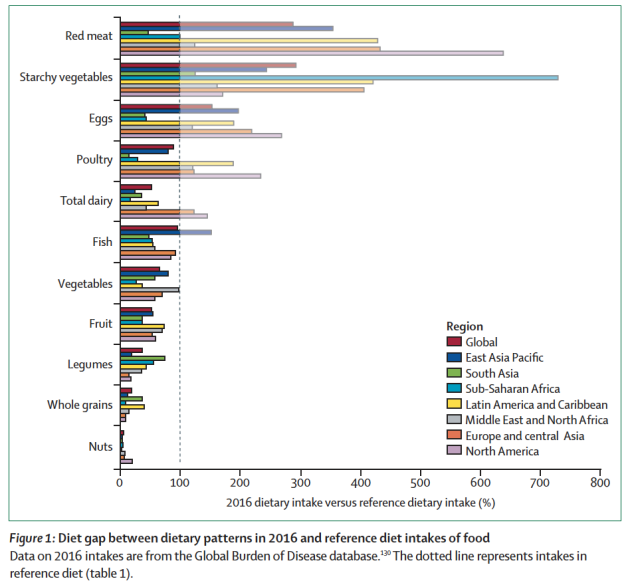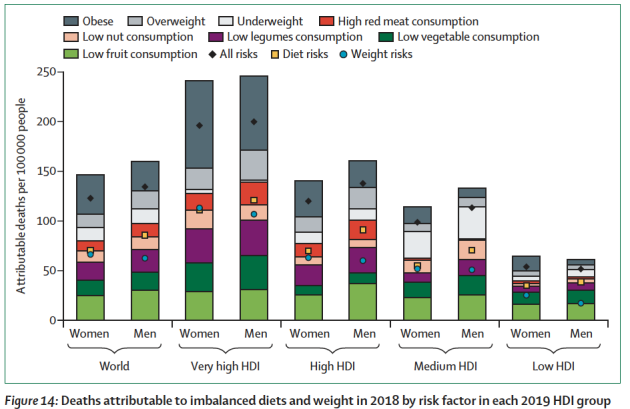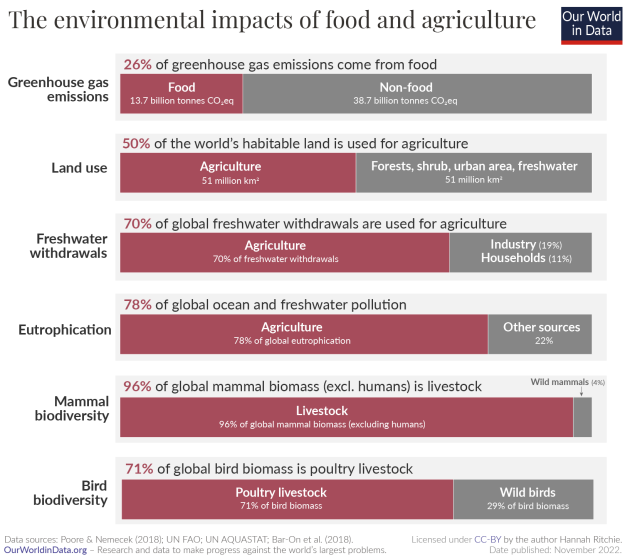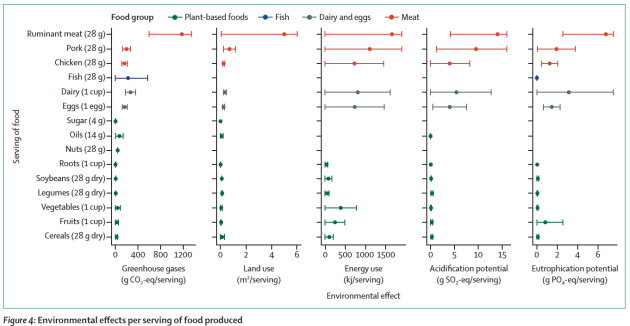Nutrition and the food industry
Worldwide food hygiene is deteriorating
Although global calorie production has kept pace with population growth, more than 820 million people lack food and even more consume poor quality diets.
A healthy reference diet consists largely of vegetables, fruit, wholegrain cereals, pulses, nuts and unsaturated oils. It includes a moderate amount of seafood and poultry, and very little, if any, red meat, processed meat, added sugar, refined cereals and starchy vegetables.
However, the global average consumption of these healthy foods is well below what this reference diet recommends, while the consumption of unhealthy foods is increasing. For example, red meat consumption far exceeds the limits of a balanced diet in almost all regions of the world, with the exception of South Asia. On the other hand, the consumption of fruit, legumes, wholegrain cereals and nuts remains below recommended levels throughout the world, without exception.
People's diets have evolved towards increased consumption of processed foods. Ultra-processed foods and beverages (UPFB) are defined as products that are not simply modified, but are composed mainly or entirely of substances derived from food and additives, with little or no intact food. In high-income countries such as the United States and Canada, AUBTs already account for more than 50% of total energy intake, and their consumption is increasing rapidly in middle-income countries. The consumption of AUBT has been associated with unbalanced diets as well as overweight and obesity.
Unbalanced diets responsible for major morbidity and mortality
Unbalanced diets lead to micronutrient deficiencies and contribute to a significant increase in diet-related diseases such as obesity, heart disease, stroke and diabetes. Such diets also carry a higher health risk than certain risky behaviours such as unprotected sex, or the consumption of alcohol, drugs and tobacco combined. Current dietary trends, combined with a world population that could reach 10 billion by 2050, will further exacerbate these risks and add to the current epidemic of non-communicable diseases.
In 2019, 11.5 million deaths were attributed to unbalanced diets. Of these deaths, 17% (around 2 million) were linked to the consumption of red and processed meat and dairy products. The majority of these deaths (93%) came from countries with a high or very high Human Development Index (HDI). In countries with a low or medium HDI, the main cause of diet-related mortality was low consumption of fresh fruit and vegetables.
The evidence linking processed and red meat consumption to cancer has been accumulating for over a decade. In 2015, the International Agency for Research on Cancer (IARC), an expert panel that evaluates scientific research, classified processed meat as a ‘definite’ cause of cancer (Group 1), alongside tobacco and alcohol. Red meat, on the other hand, is classified as a ‘probable’ cause of cancer (group 2a). These associations have been well demonstrated for colorectal cancer in particular.
The links between the consumption of ultra-processed foods (UPFs) and the risk of chronic diseases were studied in the NutriNet-Santé cohort, which tracks over 100,000 French adults. The results showed that the higher the consumption of TUEs, the greater the risk of mortality and of developing various illnesses. These include cancers, cardiovascular disease, type 2 diabetes, overweight and obesity, depressive symptoms and irritable bowel syndrome. In addition to the poor nutritional quality of these foods, other factors such as food additives and contaminants from processing or packaging could also play a role in these health effects.
Each component in the stacked bar represents its individual contribution to attributable deaths. Since these contributions cannot be summed directly, the overall contribution by diet and weight components are represented by the dots as given in the key. HDI=human development index.
A global agri-food system with an unsustainable environmental impact
The agri-food system is one of the main drivers of global environmental change, contributing to climate change, biodiversity loss, freshwater use, disruption of the global nitrogen and phosphorus cycles, changes in land use and chemical pollution.
Agriculture occupies around 40% of the world's land, and food production is responsible for up to 30% of global greenhouse gas emissions and 70% of freshwater use. The conversion of natural ecosystems to farmland and pasture is the main factor threatening certain species with extinction. Excessive use of nitrogen and phosphate fertilisers leads to eutrophication (algal blooms) and the creation of dead zones in lakes and coastal areas. Food production also has a major impact on marine systems. Around 60% of the world's fish stocks are fully exploited, over 30% are overexploited, and global marine fisheries catches have been declining since 1996. In addition, the rapidly expanding aquaculture sector can have a negative impact on coastal habitats, freshwater resources and terrestrial systems. The massive use of pesticides is also a major cause of biodiversity loss.
In addition, a growing number of studies show that there is a fairly clear hierarchy of environmental impacts between different food categories. In terms of greenhouse gas emissions, cereals, fruit and vegetables have much smaller footprints per portion than ruminant meat. Overall, studies agree that plant-based foods cause fewer negative environmental effects than animal-based foods on various environmental indicators.
Numerous studies have also evaluated the environmental effects of various diets, and most show that the effects diminish as animal foods are replaced by plant foods. Vegan and vegetarian diets are associated with the greatest reductions in greenhouse gas emissions and land use, and vegetarian diets with the greatest reduction in water use. Adopting a diet containing more plant-based foods than animal-based foods would therefore offer strong environmental gains.
Bars are mean (SD). Some results are missing for fish due to lack of data for some impact categories (eg, land use stemming from plant-based feeds in aquaculture).
This was, however, accounted for in the global food systems modeling framework used in Section 3. CO2=carbon dioxide. Eq=equivalent. PO4=phosphate.
SO2=sulphur dioxide.



